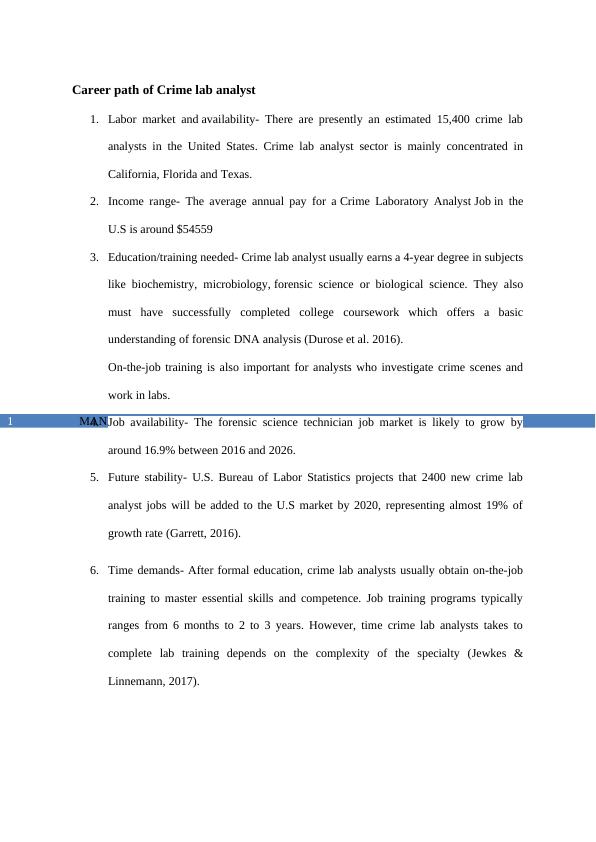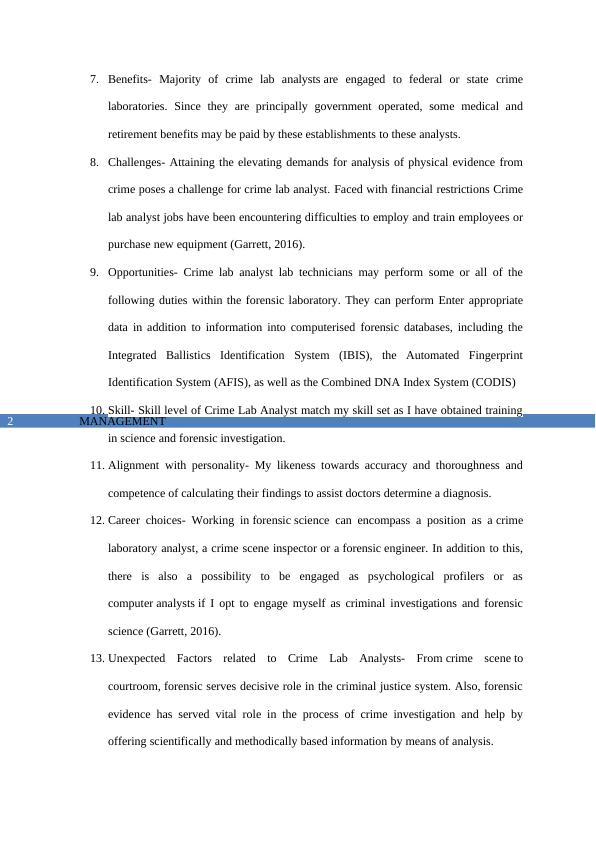Assignment (Doc) | Career Path of Crime Lab Analyst
7 Pages1487 Words23 Views
Added on 2022-10-07
About This Document
The two career choices I would like discussed are a crime lab analyst and a victim's advocate.
Assignment (Doc) | Career Path of Crime Lab Analyst
Added on 2022-10-07
ShareRelated Documents
Running head: MANAGEMENT
MANAGEMENT
Name of the Student:
Name of the University:
Author note:
MANAGEMENT
Name of the Student:
Name of the University:
Author note:

MANAGEMENT1
Career path of Crime lab analyst
1. Labor market and availability- There are presently an estimated 15,400 crime lab
analysts in the United States. Crime lab analyst sector is mainly concentrated in
California, Florida and Texas.
2. Income range- The average annual pay for a Crime Laboratory Analyst Job in the
U.S is around $54559
3. Education/training needed- Crime lab analyst usually earns a 4-year degree in subjects
like biochemistry, microbiology, forensic science or biological science. They also
must have successfully completed college coursework which offers a basic
understanding of forensic DNA analysis (Durose et al. 2016).
On-the-job training is also important for analysts who investigate crime scenes and
work in labs.
4. Job availability- The forensic science technician job market is likely to grow by
around 16.9% between 2016 and 2026.
5. Future stability- U.S. Bureau of Labor Statistics projects that 2400 new crime lab
analyst jobs will be added to the U.S market by 2020, representing almost 19% of
growth rate (Garrett, 2016).
6. Time demands- After formal education, crime lab analysts usually obtain on-the-job
training to master essential skills and competence. Job training programs typically
ranges from 6 months to 2 to 3 years. However, time crime lab analysts takes to
complete lab training depends on the complexity of the specialty (Jewkes &
Linnemann, 2017).
Career path of Crime lab analyst
1. Labor market and availability- There are presently an estimated 15,400 crime lab
analysts in the United States. Crime lab analyst sector is mainly concentrated in
California, Florida and Texas.
2. Income range- The average annual pay for a Crime Laboratory Analyst Job in the
U.S is around $54559
3. Education/training needed- Crime lab analyst usually earns a 4-year degree in subjects
like biochemistry, microbiology, forensic science or biological science. They also
must have successfully completed college coursework which offers a basic
understanding of forensic DNA analysis (Durose et al. 2016).
On-the-job training is also important for analysts who investigate crime scenes and
work in labs.
4. Job availability- The forensic science technician job market is likely to grow by
around 16.9% between 2016 and 2026.
5. Future stability- U.S. Bureau of Labor Statistics projects that 2400 new crime lab
analyst jobs will be added to the U.S market by 2020, representing almost 19% of
growth rate (Garrett, 2016).
6. Time demands- After formal education, crime lab analysts usually obtain on-the-job
training to master essential skills and competence. Job training programs typically
ranges from 6 months to 2 to 3 years. However, time crime lab analysts takes to
complete lab training depends on the complexity of the specialty (Jewkes &
Linnemann, 2017).

MANAGEMENT2
7. Benefits- Majority of crime lab analysts are engaged to federal or state crime
laboratories. Since they are principally government operated, some medical and
retirement benefits may be paid by these establishments to these analysts.
8. Challenges- Attaining the elevating demands for analysis of physical evidence from
crime poses a challenge for crime lab analyst. Faced with financial restrictions Crime
lab analyst jobs have been encountering difficulties to employ and train employees or
purchase new equipment (Garrett, 2016).
9. Opportunities- Crime lab analyst lab technicians may perform some or all of the
following duties within the forensic laboratory. They can perform Enter appropriate
data in addition to information into computerised forensic databases, including the
Integrated Ballistics Identification System (IBIS), the Automated Fingerprint
Identification System (AFIS), as well as the Combined DNA Index System (CODIS)
10. Skill- Skill level of Crime Lab Analyst match my skill set as I have obtained training
in science and forensic investigation.
11. Alignment with personality- My likeness towards accuracy and thoroughness and
competence of calculating their findings to assist doctors determine a diagnosis.
12. Career choices- Working in forensic science can encompass a position as a crime
laboratory analyst, a crime scene inspector or a forensic engineer. In addition to this,
there is also a possibility to be engaged as psychological profilers or as
computer analysts if I opt to engage myself as criminal investigations and forensic
science (Garrett, 2016).
13. Unexpected Factors related to Crime Lab Analysts- From crime scene to
courtroom, forensic serves decisive role in the criminal justice system. Also, forensic
evidence has served vital role in the process of crime investigation and help by
offering scientifically and methodically based information by means of analysis.
7. Benefits- Majority of crime lab analysts are engaged to federal or state crime
laboratories. Since they are principally government operated, some medical and
retirement benefits may be paid by these establishments to these analysts.
8. Challenges- Attaining the elevating demands for analysis of physical evidence from
crime poses a challenge for crime lab analyst. Faced with financial restrictions Crime
lab analyst jobs have been encountering difficulties to employ and train employees or
purchase new equipment (Garrett, 2016).
9. Opportunities- Crime lab analyst lab technicians may perform some or all of the
following duties within the forensic laboratory. They can perform Enter appropriate
data in addition to information into computerised forensic databases, including the
Integrated Ballistics Identification System (IBIS), the Automated Fingerprint
Identification System (AFIS), as well as the Combined DNA Index System (CODIS)
10. Skill- Skill level of Crime Lab Analyst match my skill set as I have obtained training
in science and forensic investigation.
11. Alignment with personality- My likeness towards accuracy and thoroughness and
competence of calculating their findings to assist doctors determine a diagnosis.
12. Career choices- Working in forensic science can encompass a position as a crime
laboratory analyst, a crime scene inspector or a forensic engineer. In addition to this,
there is also a possibility to be engaged as psychological profilers or as
computer analysts if I opt to engage myself as criminal investigations and forensic
science (Garrett, 2016).
13. Unexpected Factors related to Crime Lab Analysts- From crime scene to
courtroom, forensic serves decisive role in the criminal justice system. Also, forensic
evidence has served vital role in the process of crime investigation and help by
offering scientifically and methodically based information by means of analysis.

End of preview
Want to access all the pages? Upload your documents or become a member.
